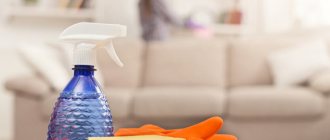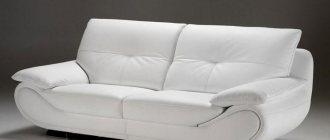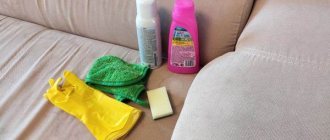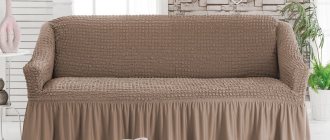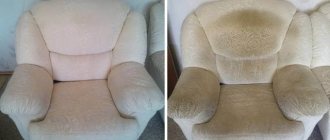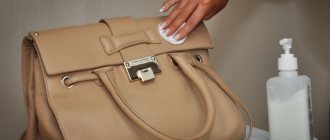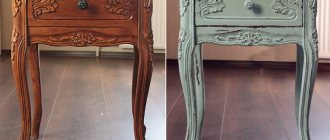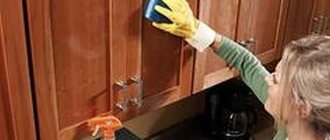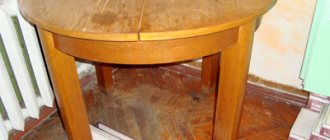Expert opinion
Irina Kovtun
A polished furniture set, without a doubt, looks very presentable and aesthetically pleasing. Therefore, housewives try to keep it in its original form for as long as possible. However, the smooth surface gets dirty quite easily and is susceptible to mechanical stress, which can negatively affect the impression of the room as a whole.
Therefore, below we will consider how to properly clean polished furniture at home.
Features of caring for polished home furniture
To ensure that the need to clean varnished furniture arises as rarely as possible, it must be properly cared for. Here are some basic recommendations that will help you keep your wardrobes, bedside tables and cabinets in perfect condition:
- Lacquered furniture must be cleaned of dust deposits daily. This should be done with a dry soft cloth.
- Under no circumstances should you install a furniture set in a room that is located on the sunny side, or in a room with high humidity. The fact is that external environmental factors can lead to deformation of polished furniture.
- Do not place dishes with cold or hot contents on a shiny, flat surface. This may lead to cracking of the coating or the appearance of whitish spots.
- It is better to install polished furniture in the kitchen away from the stove. This will protect it from fat flying in all directions during cooking, because it is very difficult to wash off. In general, to avoid such problems, it is best to buy unpolished kitchen furniture made from MDF.
- You should handle the smooth surface as carefully as possible, since polishing quickly becomes covered with micro-scratches and gets dirty.
“Disease” is better prevented
Lacquered furniture is perfect for decorating a living room or bedroom in a classic style. But in order for the interior to always make a great impression, it is worth taking care of the health of the furniture. But does furniture have diseases?!
In this case, we’ll call the spots “disease.” They can come from a specific impact (for example, from a glass of hot tea, but more on that later) or from prolonged use of furniture. How to remove stains from furniture if they appeared as if on their own, that is, simply from long-term use?
For those who regularly care for furniture, the question of how to remove stains from furniture may not arise. Simply because preventative work was carried out on time. So, let's take our experience into account.
Special wipes impregnated with wax and antistatic are well suited for caring for lacquered furniture They are also called “polishing”. By periodically wiping lacquered furniture with such a cloth, you can preserve its original appearance for a long time. As a result of the treatment, a thin film of wax is applied to the surface, which protects and adds shine.
Folk wisdom has prepared a worthy answer for manufacturers of special products. If you don’t have a polishing cloth to care for lacquered furniture, arm yourself with vegetable (or better yet, burdock) oil . A few drops should be applied to cotton wool. The cotton wool, in turn, needs to be wrapped in a soft cloth so that the oil seeps out just a little. After wiping the furniture in this way, then polish it with a dry cloth.
How to clean polished furniture
Let's figure out how to clean a lacquered furniture set, depending on the characteristics of the dirt that has appeared on it. Most of the listed funds can be found in almost every home.
From fingerprints
Even if you touch a polished table or cabinet with perfectly clean hands, fingerprints will still remain. This is due to the fact that there are sebaceous ducts on the pads, which constantly synthesize sweat and fat secretions. To clean the set from stains, potato starch is best suited. It can be used in two ways at home:
- Sprinkle dry powder onto the affected area and leave to absorb greasy residue for five to seven minutes. Then clean the polished furniture with a soft cloth.
- Use a cut of a raw potato to go over the stained area. Then rub the varnish with a suede cloth.
How to remove stains from furniture if they are quite old?
Vegetable oil will help us again. Just add table salt to it. salt and oil to the old stain and leave for several hours. Then shake everything off and polish the surface with a woolen cloth.
Milk can also help in caring for lacquered furniture . You need to soak the cloth in milk and wipe the problem areas. Dry and polish the furniture with a wool or velvet cloth.
Well, the cheapest way to remove stains from furniture. Soak a soft cloth in warm, soapy water . Wipe down the furniture and then dry it with old felt. If felt is not available, wool fabric will do.
Traditional methods
It is not always possible to immediately drop everything and run to the store to buy expensive household chemicals to clean polished furniture. Below are considered effective folk remedies that cleanse dirt no worse than store-bought products.
Beer
To clean polished furniture with a low-alcohol drink at home, you will need to follow these simple steps:
- pour a liter of any beer into a small saucepan and heat a little over low heat;
- throw a small piece of paraffin into the warm liquid and wait for it to completely dissolve;
- Treat the stained surface with the resulting liquid.
Important! The product in question can also be used to polish tarnished furniture that has been exposed with varnish.
Special solution
Many housewives are interested in the question of how to wash polished furniture so that less dust settles on it. A similar remedy exists. To prepare it you will need:
- mix fifty milliliters of antistatic for clothes and any hair shampoo in a deep bowl;
- add two glasses of water at room temperature;
- mix the ingredients thoroughly.
What you need for polishing
Now we are not talking about professional products from the store, designed specifically for the care of polished cabinets and tables. What available tools can be used for the same purposes?
- From the kitchen cabinet: vegetable oil, wine vinegar, brewed tea, salt, flour, milk, potatoes, beer, sauerkraut (brine).
- From the home first aid kit: burdock oil, talc or baby powder, ethyl alcohol.
- From the bathroom: shampoo, liquid soap, antistatic spray.
- From the pantry: turpentine, gasoline, shoe polish.
Of course, you can’t do without special equipment. First of all, you will need pieces of soft flannel and cotton fabric, a small piece of leather or suede, and cotton sponges. As well as a bowl and pan, measuring cup and knife. Since some of the products used are quite aggressive, and you simply have to work with your hands, protective rubber gloves will also come in handy.
What to look for when choosing polished furniture?
Modern polished desk for the executive office
Before you go shopping for new lacquered furniture, you should decide on the main nuances - dimensions, shape, color of the product. This will help you place your purchase wisely in the room.
Polished furniture must fit into the interior and must be combined with other elements
The following points must also be taken into account.
- Polished furniture should ideally “fit” into the interior of the room in order to set its overall style, or become a separate design item that will add a touch of elegance to the space. Therefore, retro, art deco or classic style is most suitable for such furniture.
- Consider the desired shape/type of furniture (classic, built-in, modular, sectional).
- See what materials were used in production. Wood is mainly used, but modern manufacturers use chipboard, plastic and other types of raw materials. Precious wood species (for example, oak, mahogany, walnut) are the most durable, they are less susceptible to moisture and corrosion. Cheaper varieties (pine, spruce), with proper processing, finishing and care, will last for more than a decade. But a product from this category of products can quickly dry out or become deformed if the operating instructions are not followed.
- Carefully inspect the polished surface for scratches, chips, and cracks.
- Find out what varnishes/polishes were used during production. Products processed with high-quality materials are much more resistant to mechanical damage and various types of contamination.
- Check the quality and reliability of the fittings; they must be strong and durable.
Polished furniture looks beautiful, but it is difficult to clean, and stains and damage are immediately visible on it
Dealing with minor defects
Oil-based products or stains can help remove scratches. But such compositions are not recommended for use in cases where small cracks have appeared on the surface. To remove such defects, use wax, shoe polish or walnut.
Wax crayon
To hide a scratch, you need to melt wax in a water bath and treat the problem areas with the resulting composition, wiping these areas.
Shoe polish
Shoe polish must be matched to the tone of the surface being treated. The substances included in this product fill microcracks and thereby eliminate defects.
Walnut
Use the nut kernel to rub the problem areas with light pressure. The oil released during the procedure will fill the defects.
Polishing agents
Burdock oil without additional additives will restore the shine of polishing.
Renewing the smooth layer on the surface of the furniture is necessary regularly, and after exposure to any cleaning agents, it is mandatory.
For this purpose, in addition to industrially produced polishes, you can also use homemade compositions from household substances:
- Burr oil . Plant extract is best suited for polishing furniture without adding additional components. Using a cotton swab soaked in the composition, wipe the entire surface with little effort.
- Vegetable oil with vinegar . This mixture is prepared by mixing the components in equal volumetric proportions. Then apply to polish and rub.
- Beer . A piece of wax or paraffin is added to the beer being heated for cleaning. After cooling, a composition is obtained that can clean off dirt and simultaneously polish the same area.
In more advanced cases, a complex restorative mixture will help. It is prepared by mixing turpentine, linseed oil and vinegar in a volume ratio of 2:2:1. Before use, shake the composition vigorously and apply the resulting emulsion to the area with the damaged varnish layer.
All polishing agents are rubbed in a circular motion. It is not recommended to use sponges and brushes. The best tool is flannel or suede.
In hot pursuit!
Disasters for lacquered furniture are cups of hot tea, an iron or a kettle. Sooner or later, some of this is placed on a varnished surface. And then…
In fact, everything is solvable. You can remove stains from furniture left by a hot object using paraffin. Rub the stain with paraffin, cover with a paper napkin and press with a warm (not hot!) iron. Repeat if necessary.
Another method for such stains, already mentioned above, is table salt and vegetable oil.
Main problems with lacquered furniture
Such home furnishings acquire their characteristic shine due to the fact that during the production process the wood is coated with special compounds containing resins and varnishes.
Due to these features, furniture:
- quickly absorbs various contaminants;
- prone to the formation of microcracks and chips;
- accumulates static electricity, which attracts dust.
Polished furniture has strict maintenance requirements. Such items should not be placed in rooms with high humidity levels or in places exposed to direct sunlight.
Lacquered surfaces do not tolerate temperature changes and exposure to abrasive particles. In both cases, cracks appear.
After cleaning the varnished surface with a damp cloth, stains remain, and the dry material electrifies the material, thereby facilitating the settling of dust.
Safe cleaning tools
Polished furniture can only be wiped with a soft cloth or rag.
When processing polished furniture, it is easy not only to remove dirt, but also to damage the varnish layer. Therefore, it is unacceptable to use any harsh objects - scrapers, coarse bristles, abrasive sponges.
You need to use:
- cotton and flannel fabrics;
- suede cuts;
- cotton pads and tampons;
- pieces of soft leather;
- light brushes to sweep away dust.
To remove stuck-on dirt, you will need a table knife or a metal spatula.
It is advisable not to clean the surface of the furniture directly with sharp objects, but first slightly heat the metal over a fire or in boiling water. After this, the wax or paraffin will be easier to remove from the polish.
How can you wipe furniture?
It is easy to clean furniture from dirt with a soap solution. The process is simple - grated laundry soap in the amount of 2-3 tbsp. l. dilute in 1 liter of non-hot water, moisten a cotton napkin in the solution and apply to contaminated areas.
Interesting materials:
How to display an image from a tablet to a TV via USB? How to remove moment glue from your hands? How to remove glue from hands? How to remove a cat's dog from the carpet? How to remove a sticky stain from a sticker? How to remove machine oil from jeans? How to remove oil from carpet? How to wake up the monitor from standby mode? How to display an inscription on a jacket? How to write an inscription with a pen?
Important addition
To ensure that stains on polished furniture are easy to clean and appear as rarely as possible, you should remember:
- Do not place hot dishes on an open surface. You must place a special stand under the mug or plate.
- If the stain could not be avoided, then before looking for a way to remove it, be sure to check for deformation. If only a change in the color of the polished surface has occurred, only the most gentle properties can be used.
- Be careful when working with red polished furniture. It is better to conduct a small test on an inconspicuous area to assess the quality of the coating. If there are no changes, only then proceed to the main process.
- Always strictly adhere to temporary recommendations. Do not overexpose the products you use, as they can also damage the items.
- All abrasive substances and hard brushes should be strictly prohibited. They will not remove dirt, but will only add scratches.
Thus, if you correctly approach the issue of stains on polished furniture, you can significantly update the furniture and give it a more representative look. In addition, for this it is not necessary to use expensive store-bought products, because the most necessary things can always be found in every home. It doesn’t matter if yellow stains appear on your down winter jacket after an unsuccessful wash. It happens that you have to wash vomit stains from upholstered furniture or clothes, and it is very difficult to clean a mattress from red stains and the smell of urine, but there are methods. You can, Removing stains is always a long and labor-intensive process, especially if it concerns traces of food or
Features of processing different facades
For the manufacture of kitchen furniture, MDF, chipboard, wood, plastic and glass are used. When cleaning, it is important to take into account the characteristics of each material and know how to wash the kitchen set so as not to spoil the color or texture of the surface.
MDF and chipboard
Do not use abrasives or harsh scourers to remove grease from glossy MDF. They leave scratches and spoil the appearance of the headset. Clean the gloss with gentle detergents and soft cloths. To add shine, rub the coating well with paper towels after cleaning.
Clean chipboard with a melamine sponge, alcohol, soapy water and vinegar. The laminated surface can be cleaned with dishwashing gel.
Tree
This is the most difficult material to clean, as it requires delicate care. To remove grease and other contaminants, use professional wood chemicals and soft, lint-free wipes. Do not use peroxide, ammonia, citric acid or other products containing alkali.
After cleaning, do not forget to wipe all surfaces dry. Treat them with polish or wax to protect them from dust.
Plastic
An easy-to-maintain material that withstands moisture well. But some products cannot be used for cleaning. For example, you should not clean plastic facades with aggressive solvents, acetone or chlorine - these compounds discolor the surfaces and lead to tarnishing. It is worth avoiding abrasives: the material is very soft, so it is easy to scratch.
To clean plastic from grease, use dishwashing and glass cleaners. To remove old stains, you will need stronger cleaning products: special pastes, gels and sprays.
Glass
To clean glass facades, avoid products based on alkali, soda and salt. Do not use powders or hard brushes to avoid leaving scratches. Use alcohol-containing compounds: they remove grease perfectly and do not form streaks.
General recommendations
Follow these tips:
- Wipe off greasy drops immediately so they don’t have time to dry.
- Test the detergent on a small area first. Treat the surface with the composition, wipe and check the color of the coating after a couple of minutes.
- Do not use harsh abrasives such as powder, otherwise you will damage the top layer of wood or painted surfaces.
- Use soapy water, baking soda, and salt to clean the fittings. Do not use vinegar, alkalis, citric acid or hydrogen peroxide to avoid damaging the metal.
- At the end of cleaning, wipe the kitchen with a damp and dry microfiber cloth - this will remove any remaining cleaning product and stains.
Ideal conditions for wooden furniture
Wood is a living material, sensitive to external conditions. The factors listed below can shorten the life of wooden furniture, or vice versa - preserve it for the joy of several generations of the family.
Air temperature and humidity
The optimal indicator for the good “well-being” of wooden interior elements is from 45 to 70% at an air temperature of +10 to +25 degrees.
High humidity causes furniture to swell. Paints, varnishes and glue used in its production also lose their properties when wet. Mold grows on wooden surfaces in conditions of excess moisture, and a grinder beetle can settle inside furniture components.
In excessively humid rooms, it is recommended to stick special paper on the back walls of large interior items that absorbs excess moisture.
When “saving” wet wooden furniture, slow drying is required - this is the only way to avoid deformation. Direct heat sources cannot be used for this purpose.
The most common cause of premature failure of solid wood furnishings is dry air. In an environment of excessive dryness, wood loses its natural moisture, and individual parts of the product may shrink. Such processes are often accompanied by a characteristic cracking sound. It is especially important to monitor this parameter in winter, when the air in the room becomes dry due to heating. Heated floors also do not help extend the life of wooden furniture.
There are several options for protecting furniture from dryness:
- Open the windows more often and ventilate the room;
- Place sources of moisture in the room (aquarium, decorative fountain, indoor plants);
- Buy a humidifier.
Sharp fluctuations in moisture content form stress points in the wood and can lead to fiber rupture, especially in the area where individual elements are glued together.
Features of accommodation
Wood products should not be installed closer than 1 meter from heat sources (heating systems, fan heaters, stoves). The result of such ill-conceived placement may be deformation of the constituent furniture elements, cracking, and damage to the coating.
An attractive picture - a wooden chair on a sun-drenched terrace - let it remain imaginary: solid wood furniture must be protected from constant exposure to direct rays of the sun.
Prolonged light from powerful lamps is also undesirable.
On sunny days (especially if the room is located on the sunny side), it is recommended to use translucent curtains or blinds to diffuse the light.
It is important that wooden interior items stand on a flat surface: uneven floors will lead to distortions and subsequently to changes in the shape of individual parts. This is especially true for large-sized products (cabinets). If necessary, wooden wedges of suitable size are placed under the legs of the products.
When arranging solid wood furniture, you need to take into account the distance to the nearest doors so that when closing and opening they do not touch. If this cannot be avoided, you can install a protective rubber suction cup (for example, from a soap dish) at the bottom of the door.
Protection against mechanical damage
Interior items made from solid wood must be protected from various mechanical impacts: impacts (especially from cutting objects), careless movements, etc. You should not use something very hard and sharp on the surface of such furniture. Such actions can lead to the formation of dents, chips and scratches.
The contents of wooden cabinets must be placed so that the load is distributed evenly. It is advisable to arrange things on the shelves as follows: the heaviest ones - along the edges, the lightest ones - in the central part. In cabinets, it is recommended to load the lower compartments to a greater extent - this will ensure the greatest stability.
In order for wooden chests of drawers, cabinets, and tables to serve for a long time, you need to protect their countertops from various influences.
- Flower pots should be placed on special stands; when watering, moisture should not be allowed to get on wooden surfaces. It is especially important that water does not get into the joints and crevices between furniture components.
- The use of hot mats should become the rule.
- If possible, it is recommended to cover tabletops with tablecloths or napkins.
Pine furniture requires especially careful handling: this type of wood is easily damaged.
Main
- Before deciding how to remove grease from kitchen furniture, determine the type of surface. For example, painted surfaces and wood should not be treated with abrasives or strong alkali.
- The safest traditional methods: cleaning with laundry soap and dishwashing gel - they do not leave scratches and do not spoil the color.
- Before using special chemicals, read the instructions: some products have recommended dosages.
- Wipe off grease after each cooking. It is easier to clean minor stains immediately than to scrub away old stains with professional chemicals.
